Time Management Tips of Insanely Busy People
What do the calendars of entrepreneurs, VIPs, and famous business people look like?
When I met Taylor Pearson, we nerded out over scheduling. We’d compare notes, ideas, and theories on how to optimize our time.
In the weirdest exchanging of pictures in my life, we’d share pics of…
Our calendars.
Naughty, naughty Noah.
Because I’m one to share, here’s a screenshot of my calendar:
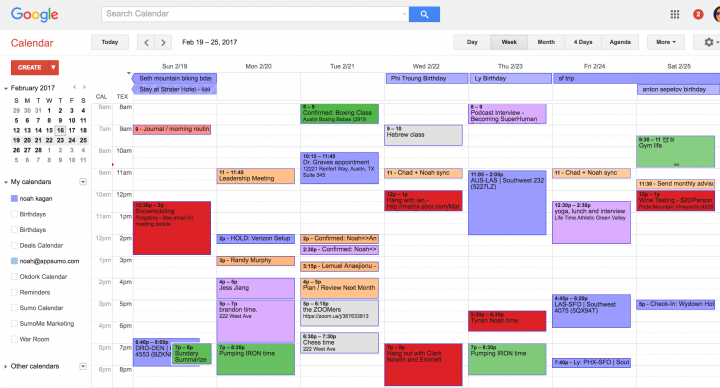
Everything is color-coded:
-
- Green = Gym
- Salmon = Sumo work
-
- Purple = Podcast planning, recording, or brainstorming
-
- Grey = Growth learning or consuming (i.e. reading)
-
- Red = Random weird and fun shit, like hanging out with OkDork readers
For some people, it’s overkill to put so much in their calendars.
But for me, it’s critical.
Being super dedicated and stringent with my time is how I grew Sumo to an 8-figure business, plus how I release so many damn videos every week.
When I optimize and manage my schedule properly, everything falls in line. My days are easier, I’m more organized, and I’m happier.
To help you optimize your own time, I invited Taylor to share the calendar tips, scheduling habits, and time optimization hacks of the world’s best.
Take it away, Taylor…
A few months ago I ran an experiment on myself that completely changed the way I spend my time.
I actually measured, tracked and analyzed it.
There’s all sorts of tools to measure, track and analyze how you spend your money or your website metrics, but not your time. And yet time is just as important if not more important, isn’t it? If you have more time you can use it to make more money or get more traffic.
The result has transformed how I spend my time. I am far better at saying no to things that don’t matter and focusing on the things that do.
Instead of giving you a bunch of broad, B.S. lessons like “watch less television!” like a bad top 10 article on BuzzFeed, I’m going to tell you EXACTLY what you need to do.
I’m going to share a simple exercise you can do this week to help you prioritize and focus on the most important things in your life.
Specifically, you’ll learn:
- How to go plan your ideal week
- Track how you actually spend your time (so you can make adjustments)
- Ways to keep this all in your calendar — so you decrease the chance of messing up
When you see what you ACTUALLY do vs. what you WANT to do every week, you’ll have a clear list of action items for how to spend your time.
That could be:
- Taking random naps (because, why not?)
- Working on fun side projects or side businesses
- Spending time with family and friends
- Or anything else
I’m not going to tell you how to spend your time — instead, I’m going to give you the secrets VIPs and insanely busy people use to make sure they’re putting their time in the right places.
Success is fundamentally about how you spend your time.
Time is the base currency of life. If you have more time, you can convert it into anything you want:
- More money (to buy tacos)
- More time with your family
- Faster progress on that project you know you should be doing
- Exercising more
- Reading more
- Watching more cat videos
Below I’ll share with you not only what I learned, and how I set up my system to find my own personal successes, but also give you the tools and resources to do it yourself.
- Experiment #1 – Organizing Time by Energy Level
- Experiment #2 – Organizing by Value
- How to Plan and Live Your Own Ideal Week
- The 80/20 Version for Busy People
Experiment #1 – Organizing Time by Energy Level
For the first experiment, I tested for two main things:
First, I thought I wasn’t spending enough of my day in “Maker” time.
Maker time is a concept from Paul Graham’s essay Maker Time, Manager Time. In it, he explains that work time can be divided into either maker or manager time.
- Manager time is usually 30 minute or 1 hour blocks of meetings, emails, and calls.
- Maker time is 2-4 hour blocks of time to really dive into a creative project — writing, coding, creating mock-ups, or mapping out a business strategy.
It’s the same thing as what Cal Newport has called “Deep Work,” the highest leverage work that you need to block out time for to move your business forward as opposed to just keep it running.
I felt like I was getting sucked into too many managerial tasks like email, meetings and phone calls and not spending enough of my time in maker mode.
Second, I thought I wasn’t spending enough time learning.
I find that I need to consume a lot of content to keep a steady “idea flow” going with my projects.
Often times, if I’m stuck and can’t figure out how to solve a business problem, I just need to put it down and read about it.
Almost all business problems have been solved by someone else and it’s a lot easier to learn from someone else than invent from scratch.
I felt like spending a little more time learning from someone else’s mistakes might save me a lot of my own time.
To solve these two issues, I came up with a categorization scheme using Google Calendar:
- Maker – Bold Green. 2-4 hour blocks of creative work
- Manager – Orange. Phone calls, meetings, email and other managerial tasks
- Admin – Bold Red. Low energy work like making a reservation at a restaurant or disputing a credit card charge
- Exercise – Turquoise. Getting swole 😉
- Learning – Bold Blue. Reading book and articles, or going through courses
- Rest/Fun/Social – Purple. Recharge time
At the beginning of the week, I planned out my ideal week:
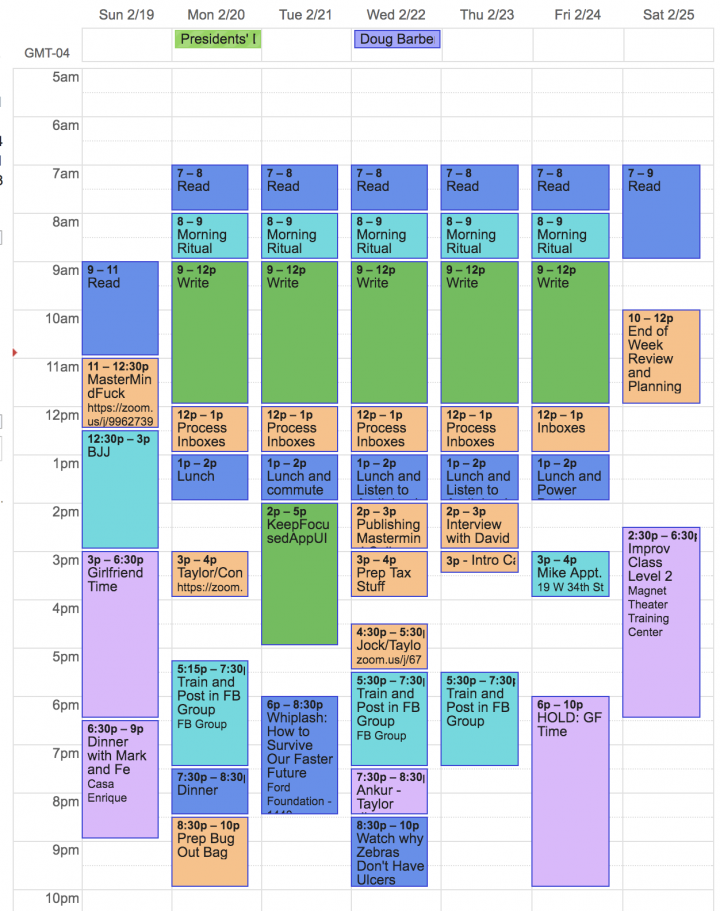
At the end of each day, I went back and adjusted my calendar to reflect how I was actually spending my time. Here’s what it looked like on my calendar at the end of week:
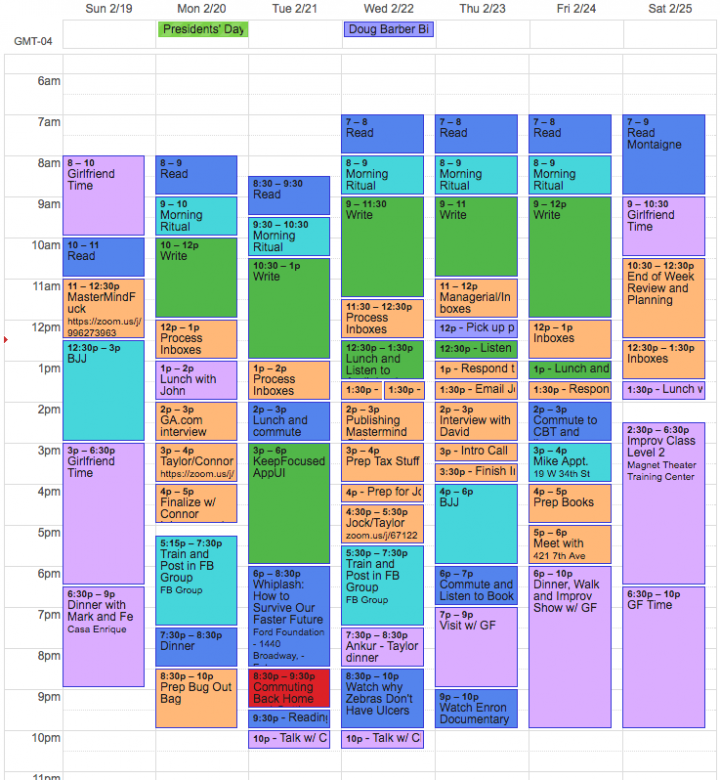
I broke that down by the categories at the end of the week:

Download a copy of this spreadsheet
What I Learned from Experiment #1
1) I was about 80% of the way there
Here’s how my actual week compared to my ideal week:
- I was spending more time in manager mode than I wanted (25% actual vs 15% target)
- My social time was less than I wanted (23.4% actual vs 30% target)
- My maker time was less than I wanted (17.55% actual vs 20% target)
The difference is because of the “domino” effect: I spent more time doing manager “admin” tasks, which took away from both social time and maker time.
Here it is in chart form:
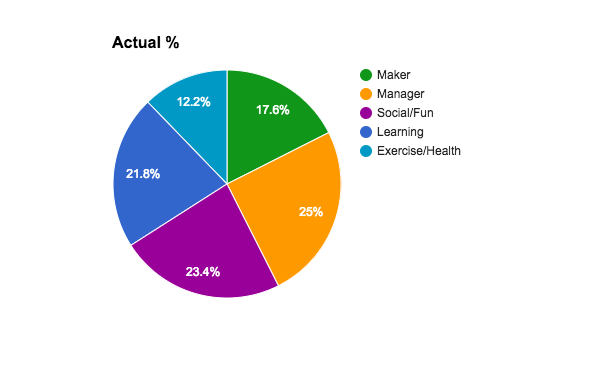
I was surprised that I was actually pretty close to where I would want to be ideally.
I think the activities taking up those chunks of time will, and should, evolve (I don’t want to be doing the same exact maker work five years from now.)
I had really been wanting to read more, but I’m reading 15 hours/week, and also doing other learning stuff (events, courses, documentaries.) That’s probably pretty close to max for me without going into information overload.
I find I don’t really have time to process it if I spend more than 4 hours a day consuming and learning. Again, this was more of a perception gap (feeling like I was not reading enough) than a reality gap.
2) How I spend time is NOT how I spend attention
Tracking my time like this made me confront how I spend my time vs. how I spend my attention.
The amount of time I spent working a lot less than I expected, but a lot of the time I spent doing other things, I was actually worrying about work.
A block of time on my calendar that said “Train at the Gym” would more accurately be labeled “train at the gym and spend all your time in between sets worrying about the 20% dip in conversion rate you just discovered.”
An hour spent reading on my calendar might really be half an hour reading and half an hour mulling over landing page layouts.
I found it hard to “single task” and focus on just one thing at a time.
Here are some of the adjustments I made to improve that.
- Reading and Maker work. I leave my phone in another room or on the other side of the room so I can’t pick it up to “check on something real quick” and end up spending twenty minutes on Twitter. I also use a tool called Freedom to block myself off distracting sites while I’m working on my computer. Noah told me he liked the Block Site plugin for Chrome that does the same thing.
- Working out. I made an aggressively loud playlist to force my brain to shut off when I’m working out.
- Shutting down for the weekend. I try to do my review and planning Saturday morning so that I can shut down for the weekend and be more present with whoever I am spending time with.
At the end of the day, all of these, though helpful, are short-term solutions. More than anything it made me double down on my mindfulness meditation practice to try and train my brain to get better at not being led down rabbit holes.
I’ve been meditating for five years and felt like I’d improved a lot but this was a reminder that mindfulness is still something I have a huge amount of room to improve on. I signed up for a weekend meditation retreat that I had been putting of for months.
3) I needed to eliminate some Manager Time
The biggest change that I realized I needed to make was to reduce some of the manager time.
I dove in and reviewed how I was spending manager time. Then, I went back and grouped the manager tasks into 6 categories.
Next to each category, I labeled how I felt about it according to 4 options:
- Great
- Good
- Ok
- Bad
For example, if I thought manager time on a specific task was REALLY beneficial to my goals I would label it “great.”
If it was a timesuck, I would label it “bad.”
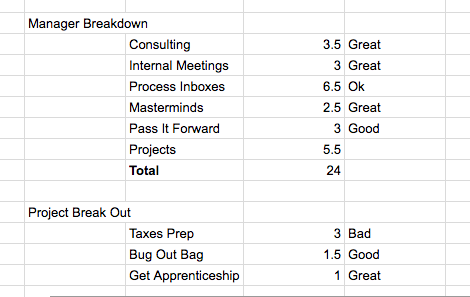
What do you notice about the breakout?
There’s one “bad” mark — which took me 3 hours of my life I’ll never get back. I realized that I could rid of the bad by hiring a bookkeeper, something else I had been putting off for months.
Here’s a second one: Even though it was “OK,” I realized I could cut down the “process inboxes” block. In other words, I could spend less time answering emails, responding to Facebook messages, and checking Twitter.
I set a goal of reducing the 6.5 hours of process inboxes to 2.5 hours per week by limiting myself to a 30-minute window each day and just responding to the most important messages.
This gave me 6 hours I could turn and put into maker time and rest time which would get me pretty close to my ideal week schedule.
4) We don’t always know what we want
Helen Fischer is a Research Associate in the Department of Anthropology at Rutgers University. She is also the Chief Scientific Advisor to the Internet dating site Match.com.
In an interview with Krista Tippett, she explained that one of the most surprising things she had found from working with Match.com was that there was very little correlation between what people said they wanted in a partner and who the actually ended up with.
Airlines spent years surveying people asking what they wanted. They got answers like bigger seats and better food. However, they eventually discovered that 90% of flyers choose their airline based on price.
This is a problem called revealed preference (what people actually want) vs. stated preference (what people say they want).
This is true of business, too. Here’s a test:
- Tell your friends a crazy business idea you have and ask them what they think
- Create a minimum viable product for your business idea, show it to them, and ask if they want to buy
Your friends might say something sounds neat… but when you actually ask them to spend money on it, they get cold feet.
Something similar happened with my schedule.
How I thought I wanted to spend my time in an ideal world wasn’t how I actually wanted to spend my time.
In order to get down to exactly the schedule I said I wanted, I needed to cut more manager work out.
The obvious thing to cut was “Pass it Forward” time. This is time I spend to help a friend or reader with a project they’re working on. I could stop doing this, but I realized that it was more important to me than getting another 3 hours of maker time or reading time. Lots and lots of people have helped me out and it makes me feel really good to spend some time passing that forward.
5) The opportunity cost of saying “Yes”
By tracking my time in detail, I was able to actually figure out what tradeoffs I was making.
Often times, we say yes to something because we don’t realize the opportunity cost of our time.
Everytime we say yes to one thing, we are necessarily saying no to something else. The number of hours in a day and days is a week is fixed; you can not create more of them.
When someone asks if you have time for a meeting next Tuesday, you may have nothing on your calendar, so you say “sure.” If you hadn’t agreed to the meeting, you would have done something with that time – but what?
By getting clear on what the “what” was that I could be doing made me better at saying no.
When you say yes that one hour phone call next week, you are saying no to revamping your sales page or going to the gym or getting home an hour earlier.
There is not always a right or wrong answer, but if you realize what you are saying no to every time you say yes, then you can make a judgement call: “Is this phone call more important to me than going to the gym today?”
If yes, then do it. If not, then don’t.
Experiment #2 – Organizing by Value
The week after I finished Experiment #1, I was having coffee with a friend and he suggested categorizing the week by the value of the tasks, instead of energy level like I did above.
Some tasks may qualify as “manager”, which seem bad on the surface. But, when we dive deeper we realize they’re extremely valuable (like negotiating a big joint venture deal or selling a high-end package).
How do you determine the value level of a task?
I used a table provided by Perry Marshall in his book 80/20 Sales and Marketing that broke tasks down into $10 – $10,000 per hour:
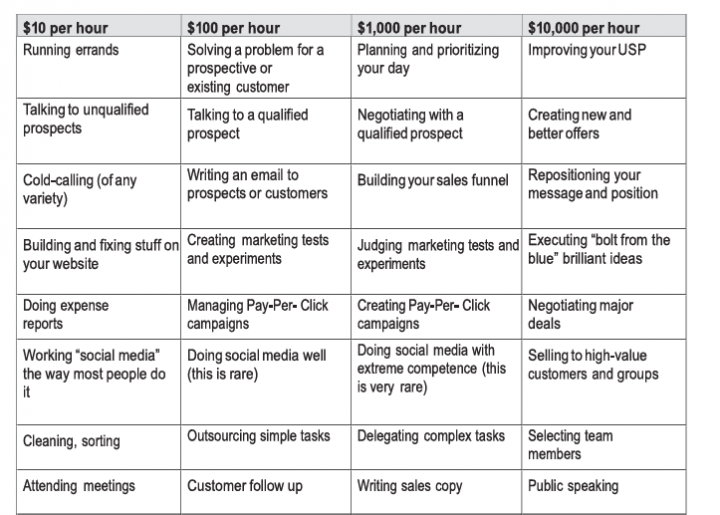
For tasks that weren’t included in Perry’s list, I used a similar four tier system from Dan Sullivan to group activities:
- Unique Ability Activities ($10,000/hour work). Tasks at which you show superior skill, energy, passion and desire for never-ending improvement
- Excellent Activities ($1,000/hour work). Tasks which you have superior skill and reputation, but no passion
- Competent Activities ($100/hour work). Tasks where you met minimum standard, but cause you anxiety and feel repetitive
- Incompetence Activities ($10/hour work). tasks you constantly encounter failure, frustration, conflict and stress.
Here’s a personal example: Bookkeeping which annoys me and takes up tons of valuable time and mental energy — according to the chart above, it’s a $10 per hour task
On the other hand, writing articles and essays is something I really enjoy doing.It’s a $10,000/hour Unique Ability.
Note: I don’t actually make $10,000 per hour immediately after writing, but the doors it opens adds up. The same idea I come up with for an article can become a book. That book can lead to courses, consulting, events or other backend services.
Based on combining these systems, here’s the new scheme I came up with:
- Bold Green – $10,000 per hour (Unique) tasks
- Yellow – $1,000 per hour (Excellent) tasks
- Orange – $100 per hour (Competent) tasks
- Bold Red – $10 per hour (Incompetent) tasks
- Turquoise – Exercise
- Bold Blue – Learning
- Purple – Rest/Fun/Social
Just like in the first experiment, I planned out my ideal week to start, then went back and updated my calendar at the end, to show how I was actually spending my time.
Here was what the plan looked like:
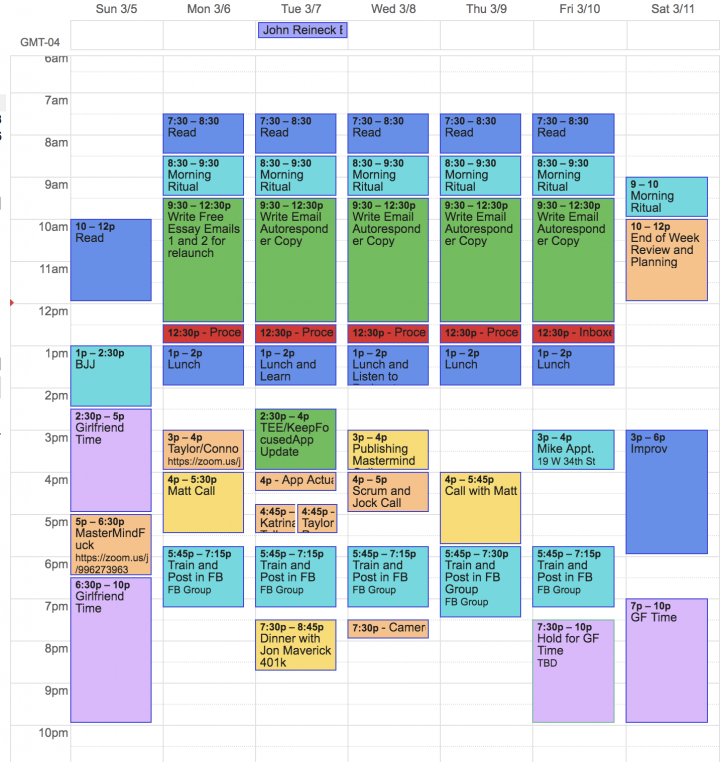
Here was how it came out:
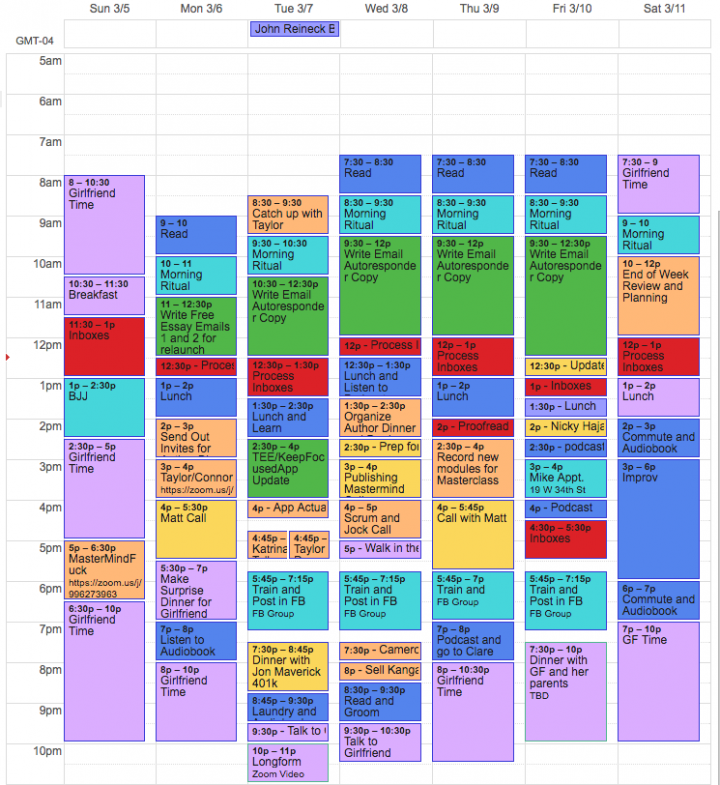
This new system forced me to be honest about how valuable specific tasks were.
A phone call where I was building a valuable partnership or developing culture might be $1,000 or $10,000 per hour work. On the other hand, “busy” work which I do to keep myself distracted wasn’t worth anything… and it was now staring me right in the face.
What I Learned from Experiment #2
1) I needed to reduce my $10 per hour and $100 per hour task time
Here’s what my time breakdown looked like:
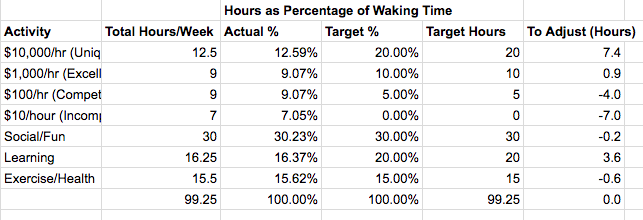
A phone call where I was making a restaurant reservation or going over administrative activities might be $10 or $100 per hour work.
Here it is broken down in Chart Form:
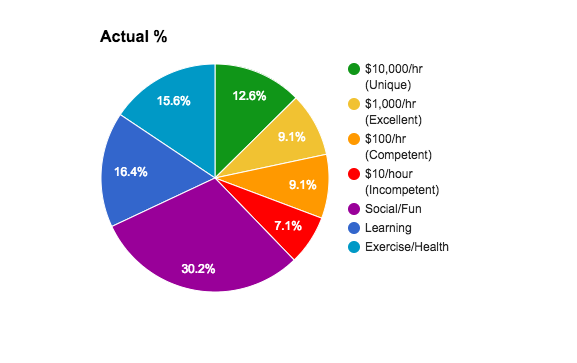
7 hours for my $10 per hour tasks, and 9 hours for my $100 per hours tasks, was too much, so I made a list of what those were to decide where adjustments could be made:
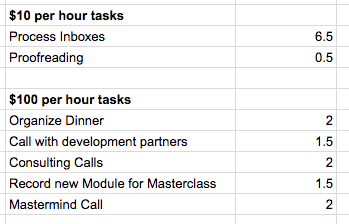
Process Inboxes: My plan from Experiment #1 to reduce the time spent processing inboxes hadn’t worked. I spent less time on it during the week, but had to make up for it on the weekend.
A part of this was imagined value vs. perceived value.
Bucketing ALL email into the $10 per hour mindset was the wrong way to look at it.
For example, the time responding to important messages from clients and prospective clients was way more valuable than $10 per hour.
It’s more accurate to say that email has very fast declining marginal returns. The first 30 minutes of email in a day is $100 per hour work. It falls off steeply from there.
I went back in and set up more filters to let my most important emails into my inbox, and keep everything else tucked away to look at only if I want. Hiring an assistant to filter the $10 emails out is probably the next step.
Proofreading: This is something I would normally hire out, but I was on deadline and didn’t have time. Since that isn’t a recurring problem, I’m not worried about it. It’s unlikely to show up in other weeks.
Organize Dinner: Organizing a monthly author dinner I host in New York was something I knew in the back of my head I should have been outsourcing for a long-time, but seeing it on paper made finally pull the trigger and get it off my plate.
Call with Development Partners: This was a couple one-off call about an app I was considering getting developed. Since it wasn’t something I was going to be doing repeatedly, I ignored it. Before I spend a lot of time solving a problem, I always ask myself “If I ignore this problem, will it go away?” If it will, I just ignore it.
Consulting Calls and Mastermind Calls: The consulting calls and mastermind calls I find really valuable. I thought about replacing them with potentially higher value tasks, but could not think of anything.
Record New Module for Masterclass: For the masterclass module, I realized that it was better to do product revamps all at once instead of gradually over time.
2) Tasks that seem the same can have dramatically different values
In his document Perry lists “attending most meetings” as a $10 per hour task and “Establishing values and culture” as a $10,000 per hour task.
On my calendar, both these activities might be labeled as “team meeting” but how they were conducted dramatically altered the value. Was I using the meetings as lessons, and referring back to our culture document? Or was I just solving immediate, small problems with little long term benefit?
I was perhaps generous with myself in ranking the week I spent rewriting an autoresponder as $10,000 per hour work.
I was repositioning the product which Perry would rank as $10,000 per hour, but in truth it might be more accurately a $1,000 per hour “building your sales funnel task.”
Just like with the meetings, the valuable thing was that I actually had to have this conversation with myself. Was I just making marginal, sustaining improvements to the auto-responder when I could have been focusing on bigger potential, breakthrough ideas?
How to Plan and Live Your Own Ideal Week
Excellence is an art won by training and habituation. We do not act rightly because we have virtue or excellence, but we rather have those because we have acted rightly. We are what we repeatedly do. Excellence, then, is not an act but a habit. -Aristotle
Assuming you spend about nine hours in bed per day, you have about 100 hours per week of habitual behavior to shape your future.
Here’s how to measure and improve yours.
Stage 1 – Planning: Do this Right Now/Beginning of the Week
1) Pick your Categories
You need to plan out how you want to spend your ideal week before you can start reviewing it. Here’s a recap of the two systems I used:
Sorting by Energy Level:
- Maker – Bold Green: 2-4 hour blocks of creative work
- Manager – Orange: Phone calls, meetings, email and other managerial tasks
- Admin – Bold Red: Low-level but necessary work like making a reservation at a restaurant or disputing a credit card charge
- Exercise – Turquoise: Getting swole 😉
- Learning – Bold Blue: This could be reading books, articles or going through course
- Rest/Fun/Social – Purple: This is recharge time.
Sorting by Value:
- Green – $10,000 per hour (Unique) tasks
- Yellow – $1,000 per hour (Excellent) tasks
- Orange – $100 per hour (Competent) tasks
- Bold Red – $10 per hour (Incompetent) tasks
- Turquoise – Exercise
- Bold Blue – Learning
- Purple – Rest/Fun/Social
There may be other categories you want to include for things you are prioritizing. Some examples might be:
- Spiritual/Religious – I lumped this into health personally, but if it’s something you think of as a category itself, separate it out
- Family/Kids – I lumped all my social time together, but you may want to prioritize how much family/kids time you are spending
- Different types of exercise – Maybe you do some conditioning and some strength training, or some general fitness and some sport specific training and you want to separate these out
- Time spent eating tacos – Kidding (sort of.)
If you want to download a worksheet where you can do all this, click here.
Or, if you want to create this on your own spreadsheet, here’s how to do it…
Keep it to no more than eight categories. I find it gets too confusing after that.
For the purposes of this example, I am going to use the system from experiment #2 going forward. You can choose whatever is most important to you.
Put these in the first column of your worksheet like so:
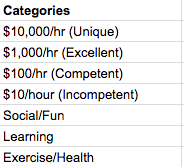
2) Pick a color scheme
Assign a color to each category and put these in the second column of your spreadsheet:
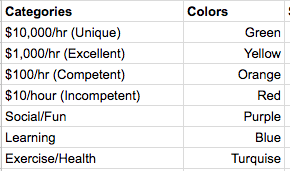
I picked green, yellow, orange and red for the different levels of work to be like a traffic light.
- Green = Go! Do more of it!
- Yellow/Orange = Caution, be careful about doing too much of this.
- Red = Stop doing it.
I picked purple, blue and turquoise for the more rejuvenating activities so I could tell at a glance whether my calendar had a good balance of work vs. rejuvenation.
3) Plan out your ideal week
Now you’re going to go into your calendar and plan out how you would ideally like to spend your next week.
You’ll already have some events scheduled in there, label them the appropriate color for new scheme. In my scheme, going to the gym would be turquoise so I would label all my scheduled gym sessions turquoise.
After that, plan out your week in this order:
- Rest/Fun/Social – Purple
- Exercise – Turquoise
- $10,000 per hour (Unique) tasks – Green
- $1,000 per hour (Excellent) tasks – Yellow
- Learning – Bold Blue
- $100 per hour (Competent) tasks – Orange
- $10 per hour (Incompetent) tasks – Bold Red
Sorting By Energy Level
- Rest/Fun/Social – Purple
- Exercise – Turquoise
- Maker – Bold Green
- Learning – Bold Blue
- Manager – Orange
- Admin – Bold Red
Why this order?
This is what I’ve found to be the most effective prioritization scheme for long-term productivity.
Rest always come first. If you’re the type of person who tracks their time using a color coded calendar, you are also probably the type of person who doesn’t rest as much as they should. This leads to a cycle of almost manic productivity (I’m killing it!) followed by burnout.
By making sure you have down time every week, you’re setting yourself up for being more productive in the long run.
You need to plan your rest time just as seriously as your weeks. Many clients I’ve worked with (including myself) will plan their work schedules down to the second, but “wing it” when it comes to rest or exercise time.
Make appointments with yourself to go for a walk, watch a movie, or take a taco cooking class.
After rest time, exercise always comes next. It’s one of the easiest things to skimp on, so planning it when you’ve got a more open calendar means you can pick times that are likely to actually work.
Like rest, planning time to exercise also sets you up to be more productive long-term.
Next comes high priority work (Maker work or $1,000-$10,000/hr work).
Then learning.
Then low priority work (manager and admin or $10-$100/hr work).
As you go through this, you may notice that some things aren’t quite the way you would like them. That’s OK. You can fix them.
Here was my plan for a recent week.:
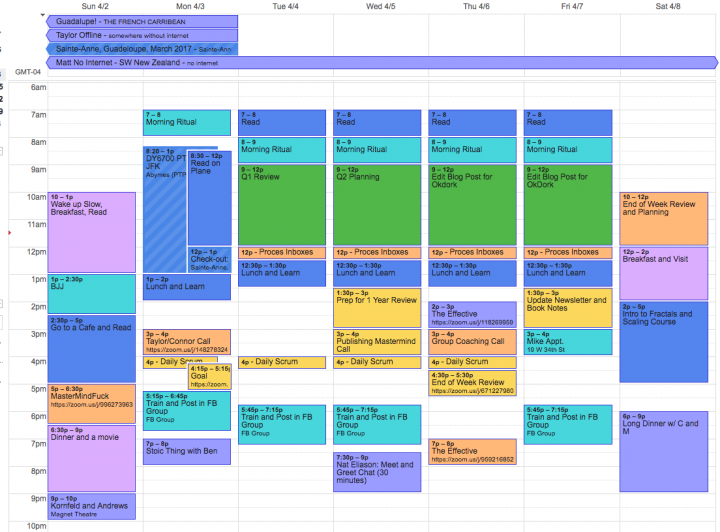
Having done this for years, my piece of advice is to try to keep your schedule about 70-80% full.
This leaves margin for unexpected things that pop up.
Stage 2 – Tracking: Do this During the Week
4) Adjust your calendar at the end of the day
Create a to-do or make it part of your end of the day review (or next day planning) to adjust your
calendar to reflect how you actually spent your time for the previous day.
Life does not go as planned, and you want an accurate look at how you are actually spending your time, not just how you plan to spend it.
Here’s how I planned to spend one Thursday vs. how it actually happened:
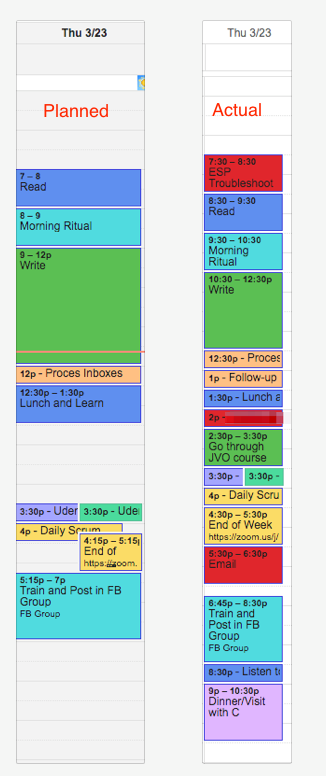
Stage 3 – Analysis: Do this at the end of the week
5) Figure out how you want to be spending your time.
Before you sit down and analyze your previous week, you want to figure out how you ideally want to be spending your time.
You have roughly 100 hours of waking time each week. How many of those hours do you want to spend in each category you listed?
Add that to the Target Percentage (column M) of the spreadsheet.
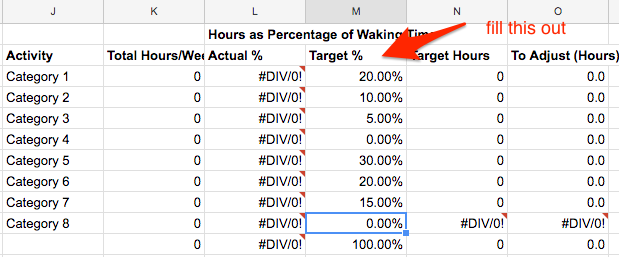
6) Calculate how you are actually spending your time
Going day by day, look at your calendar to determine how many hours you spent on each activity, then fill out the columns in the spreadsheet with how you actually spent your time.
Your worksheet should look something like this now:

At this point the worksheet will automagically calculate everything else.
In the “to adjust” column, it will show you how far off the way you actually spend your time is from how you would ideally like to.

7) Analyze your learnings
The last step is the most critical and the easiest to skip – the review. If you’re like me and most everyone else, you get to the end of the week and you’re so tired that the thought of reviewing everything feels like one more item on the to-do list.
I do two things to get myself to go through my review:
- I make my weekly review where I analyze my learnings the last thing I do for the week so that some time to relax on the weekends can be a reward. For me, that means going to a coffee shop for a couple hours on Saturday morning, analyzing my week and then closing my laptop until Monday morning.
- I remind myself that it is my time to work ON my life, not just be caught in the stream of what’s going on. If I can figure out how to save myself an hour every week, then a single review session could be worth 52 more hours in the first year. Does it make sense to spend 1 hour in order to get back 52? Heck yeah.
Once you are at the end of the week, ask yourself: How you are spending your time differently from how you planned to at the start of the week?
Were you doing too much $10 work?
If so, here’s my three step checklist for getting low value tasks off my plate:
- Is it beneficial? If not, stop. I realized a few months ago that I was spending a lot of time promoting content in places that didn’t drive any traffic. No more of that.
- If it is beneficial, can you automate it? I was manually adding people who purchased my masterclass to an email sequence and realized I could easily set up Zapier to do it for me. Are you manually doing something that could be done with tools like Zapier?
- If you can’t automate it, can you outsource it? Services like FancyHands let you outsource small amounts of work (1-5 hours/week).
Were you waking up too late (or going to sleep too late)?
Or maybe you realize, like I did, that how you think you want to be spending your time isn’t exactly how you really want to be spending it.
Put together a list of 3 things you can change next week in the improvement ideas column.
To motivate yourself to take action, describe the benefit: Will it free up your time? Prevent stress? Let you work on tasks you enjoy more?
Then write the first specific action (something you can do in less than 30 minutes) to make each improvement idea into a reality.
List the deadline you will have it done by.
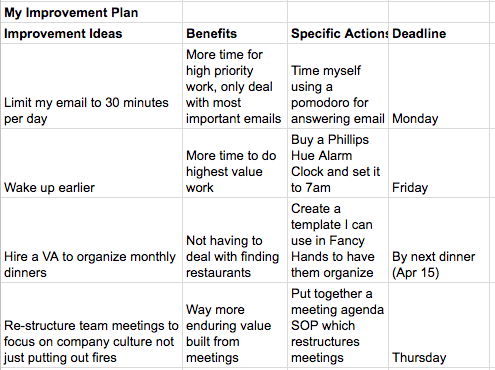
The 80/20 Version for Busy People
Essentially, the whole exercise can be boiled down to…
- Pay attention to how you are spending your time
- Decide how you would like to spend your time
- Compare the reality to the goal
- Make a plan to get the reality of how you spend your time closer to the goal
For those of you that love to nerd out, there’s the full method above, but you could do a much simpler (and still super effective version):
- At the end of the day, write out how you would ideally like to spend your day tomorrow
- Track your time tomorrow
- Compare the reality of how you spent your time vs. the ideal of how you would like to spend your time
- Pick one thing you can change to move you closer to your ideal day
If you do this once a month, it will take you 30 minutes a month and within six months, you’ll make huge progress.
Time is the only non-renewable resource
There is only one truly non-renewable resource: time. Unlike money, you can’t make more of it.
Yet, most people spend their time without ever thinking about it.
Bonnie Ware, a palliative nurse who took care of patients at the end of their lives, found that many patients had gone their whole lives without really examining how they spent their time.
She noticed that five themes surfaced over and over again.
- I wish I’d had the courage to live a life true to myself, not the life others expected of me.
- I wish I hadn’t worked so hard.
- I wish I’d had the courage to express my feelings.
- I wish I had stayed in touch with my friends.
- I wish that I had let myself be happier.
Can you relate? Have you ever looked back at a period in your life and thought “I could have spent my time so much better!”
Maybe it’s spending more time with family and friends, working on projects you really care about (instead of the ones other people were telling you to do), or going to the gym regularly.
The good news is that it’s not too late to start spending your time on what really matters to you.
Today you did something that many of Bonnie’s patients didn’t do until it was too late: Consciously think about how you want to be spending your time.
Now, it’s time to start spending your time that way right now — even if it’s only an hour a week.